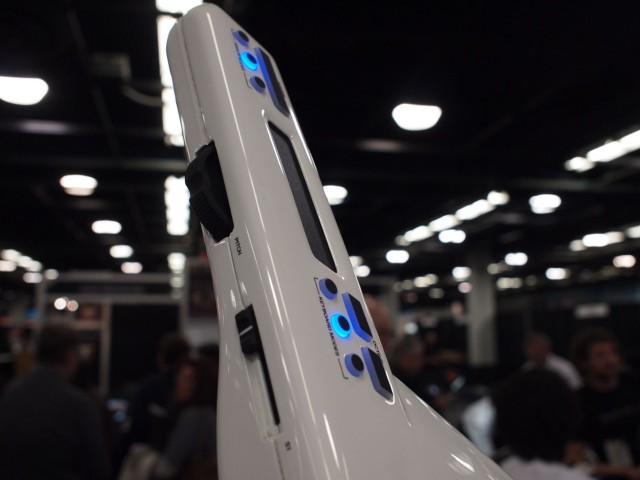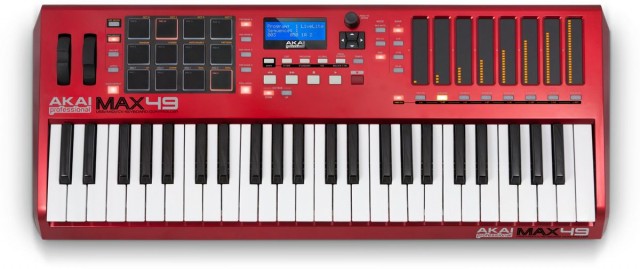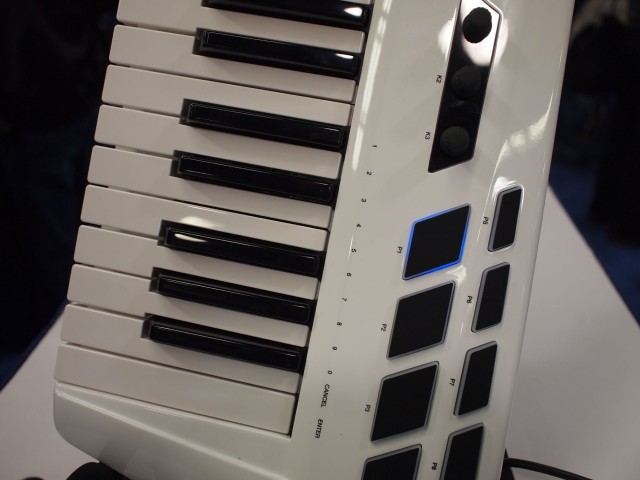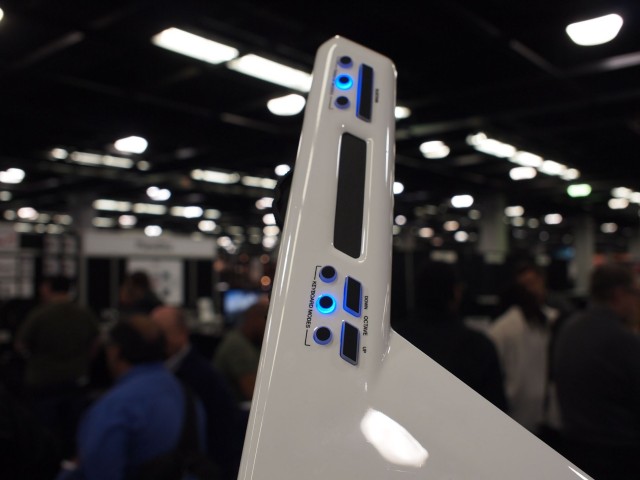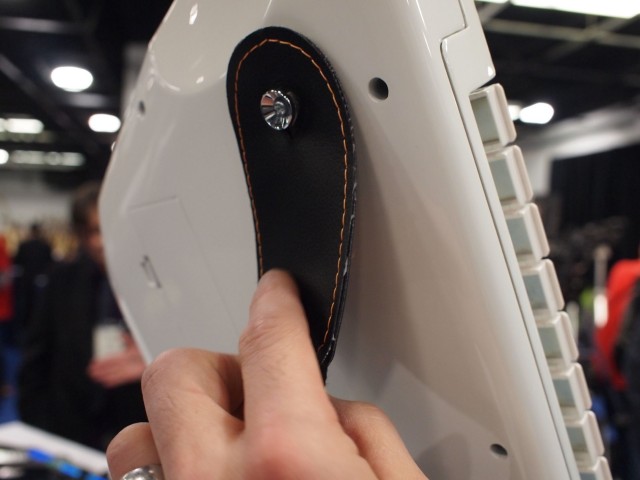One is a keytar. One is a master controller with touch faders and real MIDI and — control voltage, for working with analog gear. Seriously. The keyboard controller market may have faded into a dull, gray blur of nearly-identical models, but under the Alesis and Akai monikers, there’s some fresh-looking variety. Love it or hate it, these are not the same keyboards you’ll get from anybody else at the moment.
I got to meet with Alesis/Akai/Numark today at the NAMM Press Preview, get my hands on a prototype of their new Vortex keytar, and talk about what they’re doing. And I have to say, I’m impressed. (I didn’t get hands on the second model, the MAX49, but will visit their booth in the next couple of days.) Finally, we get the return of the MIDI DIN port for working with a wider range of hardware, without sacrificing USB. One model even does CV for analog equipment. And both can supply their own power so you can use them with iOS. And they at least are interesting enough to have an opinion about them – even if you hate them.
Here’s a look at each of them and what why they’ll be on our radar when they ship later this year.
Alesis Vortex Keytar
First off, let me say it, once and for all: I don’t think there’s anything dorky about a keytar, other than the name. Us keyboardists are plenty capable of being dorky on our own, but don’t blame the instrument.
What keytars are – or strap-on keyboards, if you can say that without smirking – is eminently practical for one-handed playing. For two-handed playing or more conventional piano or organ parts, of course, you’re better off without them. But the keytar lets you move around, play expressive solos, and also free up your hands if you’re using other machines, as in electronic music. Unfortunately, the options out there have been overly large, making them too unweildly for many people to play, and overly expensive, pricing them out of a lot of their market. I’ve played and advocated the Rock Band game controller because it’s lightweight, inexpensive, and nicely made, and it even has a MIDI jack. I actually hear one Harmonix veteran is now at Alesis, so that may be no coincidence. (The Vortex even has a touch strip on its neck.)
The Vortex, though, looks like the first really balanced keytar controller in the market … well, ever. Features:
- MIDI DIN and USB MIDI
- Velocity-sensitive pads in addition to the keys
- 37 velocity-sensitive keys (good number for a keytar), plus channel aftertouch (heck, yes)
- MIDI-assignable accelerometer. And this is cool – it’s not on all the time; you make a quick sweep of the neck to enable the accelerometer in a clever gesture control.
- MIDI-assignable touch strip, but also a full pitch bend wheel underneath your thumb (I rather prefer the latter, but it’s nice to have a choice).
- Assignable slider under your thumb, mapped by default to volume.
- Dedicated sustain button, plus octave selection, transport, and patch select.
With all due respect to Roland, this appears to fix effectively all of my complaints about the Roland keytars at a fraction of the price.
And you can add a strap via standard guitar strap pegs.
The best part:
Q2-2012
MSRP US$399
Estimated street US$249
Akai Pro MAX49: Touch Faders, CV
I’ve all but begged manufacturers to explore what an advanced or high-end MIDI controller would look like. The MAX49 likely won’t please everyone, but it’s one compelling-looking answer. Features:
- 49 semi-weighted keys, with channel aftertouch
- 12 MPC pads, backlit, four banks each
- 8 LED touch faders in place of physical faders, four banks each
- Control Voltage and analog Gate outputs for use with analog and vintage gear
- Arpeggiator with latch
- Step sequencer
- MPC swing, Note Repeat, Full Level, navigation – and yeah, I use this stuff, even if the software can do the same
USB MIDI, MIDI DIN, connect to anything - Control surface mappings plus full Mackie Control and HUI support – and, sorry, but for all the fancier solutions, sometimes that’s the easiest way to control a variety of software like Ableton Live, Reason, and the other DAWs
So, basically, all the features you want. My only questions are what it looks like in person and how the action feels, particularly those touch faders, as that can be tricky to pull off.
But the features are just perfect. It’s about time to bring back aftertouch and to connect with actual MIDI gear. Adding CV is a delicious addition. And honestly, features like being able to switch on an arpeggiator are far more useful and appealing to average musicians than the hard-to-configure, often-gimmicky automatic control features on many of the keyboards out there. So I’ve got my fingers crossed that the build quality and usability here are good — and that some of Akai’s rivals start taking on similar features. It’s bizarre to be applauding adding features from the 80s and 70s, but some recent progress has been steps backward, not forward.
Q2 2012
MSRP US$699
Estimated street $499
There are other new Alesis keyboards out this week, but the Akai MAX49 pretty much steals their thunder.
More Vortex Photos
Back to the Vortex, since I got to snap some shots this morning in Anaheim.
Discuss.
